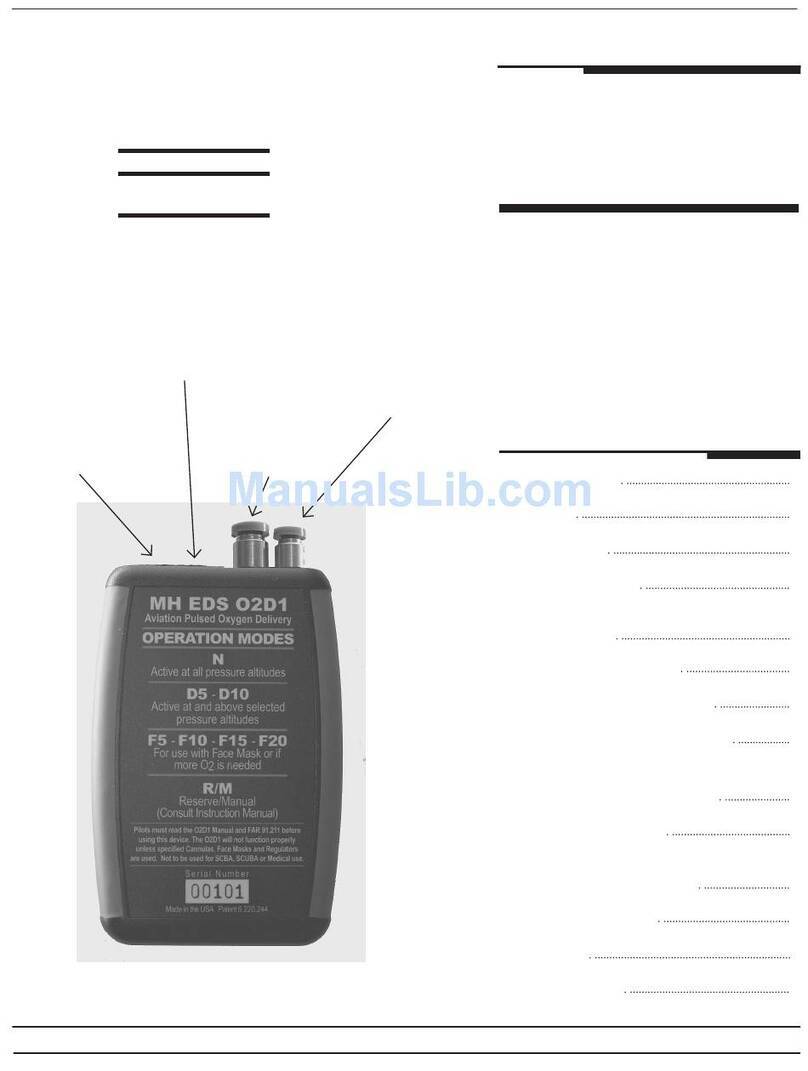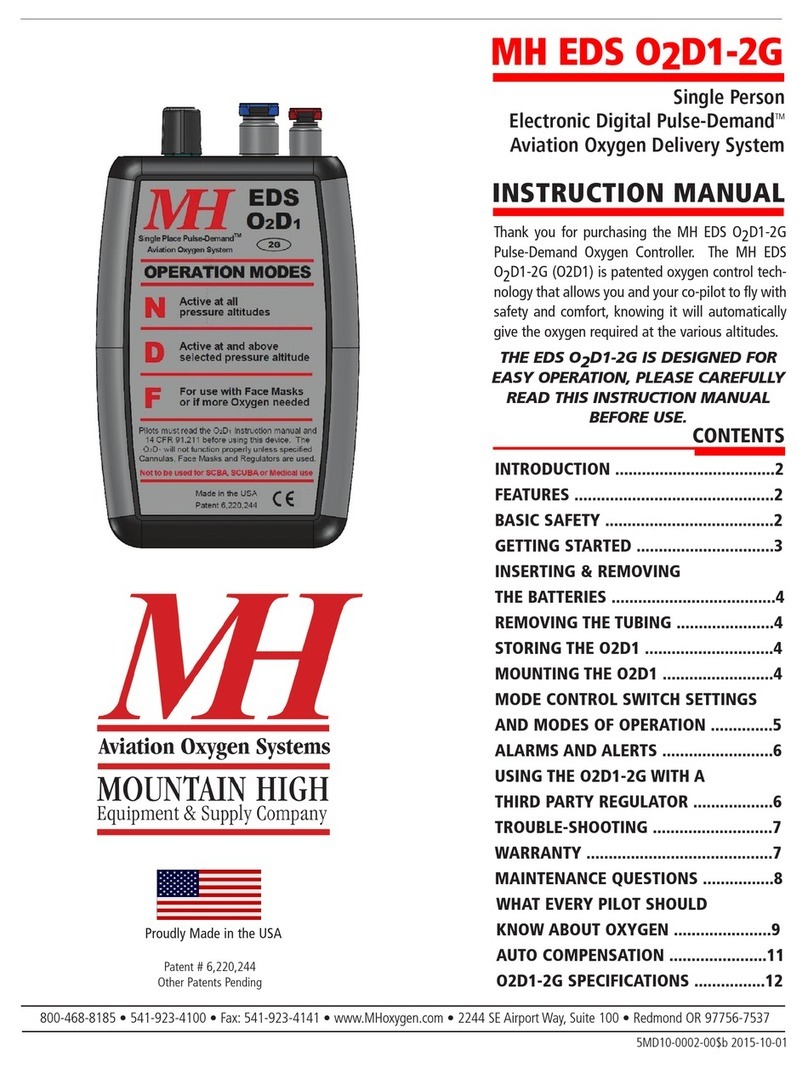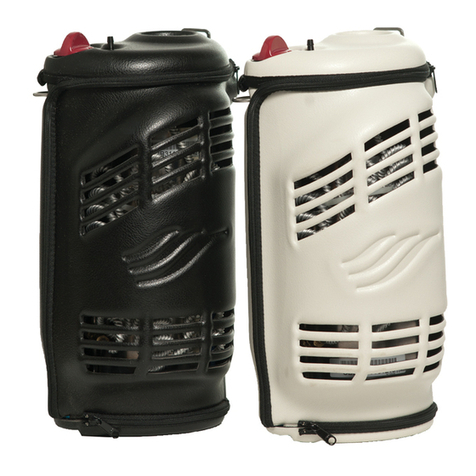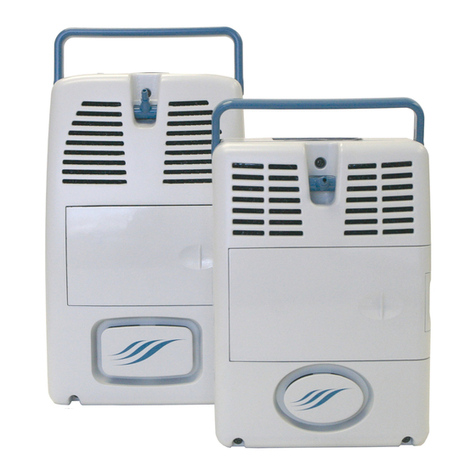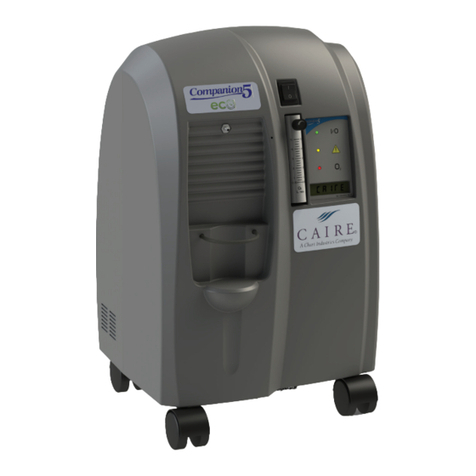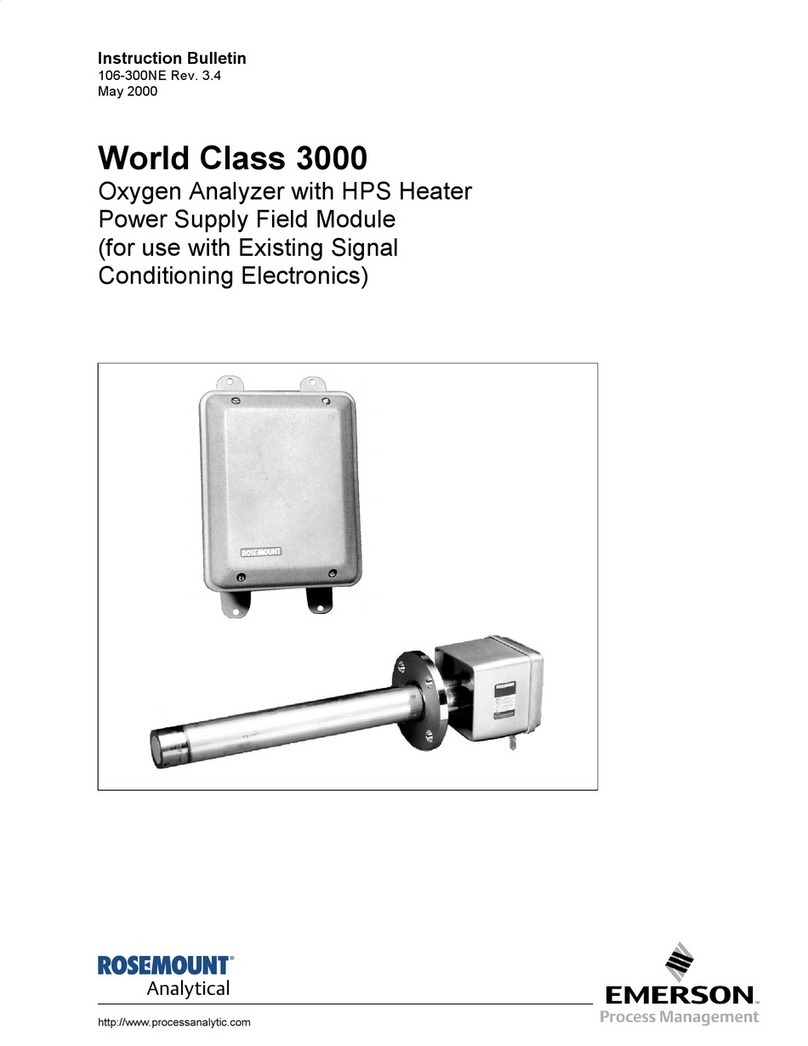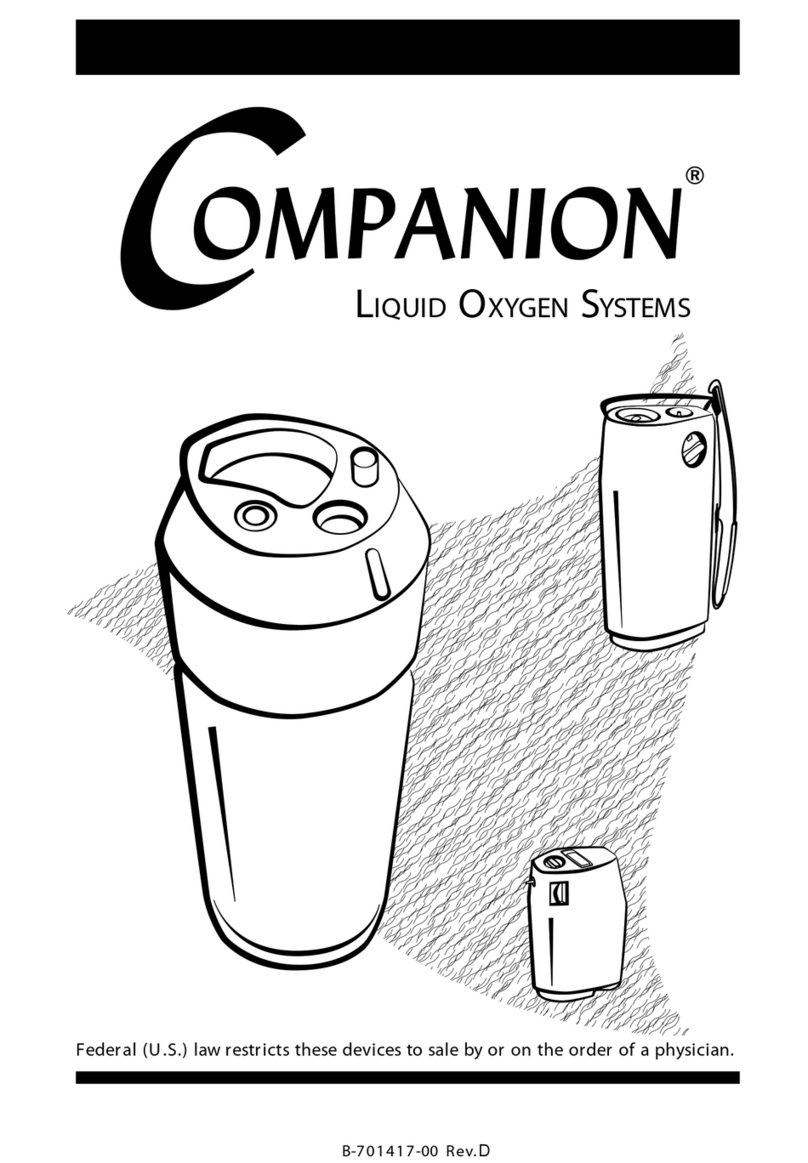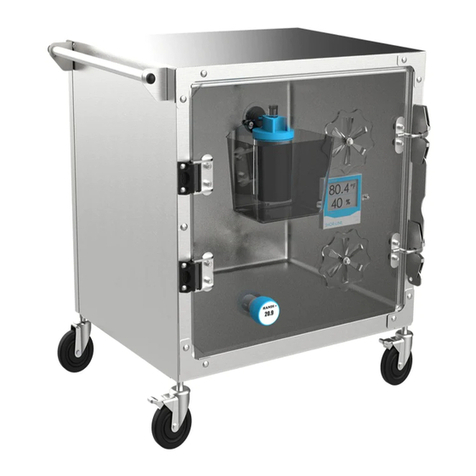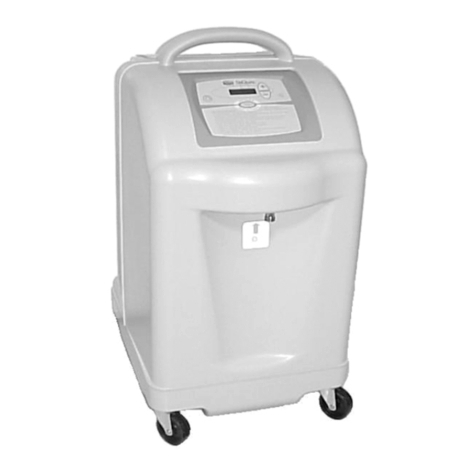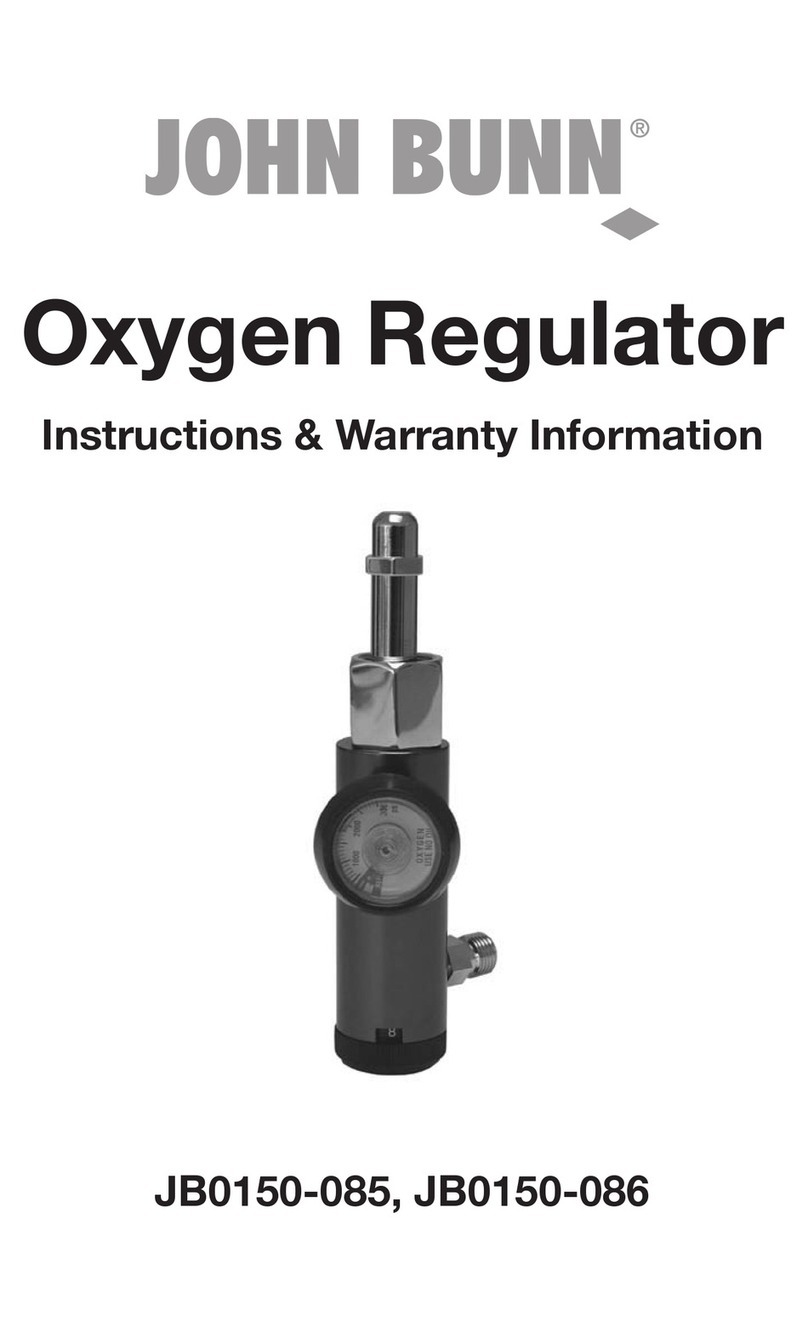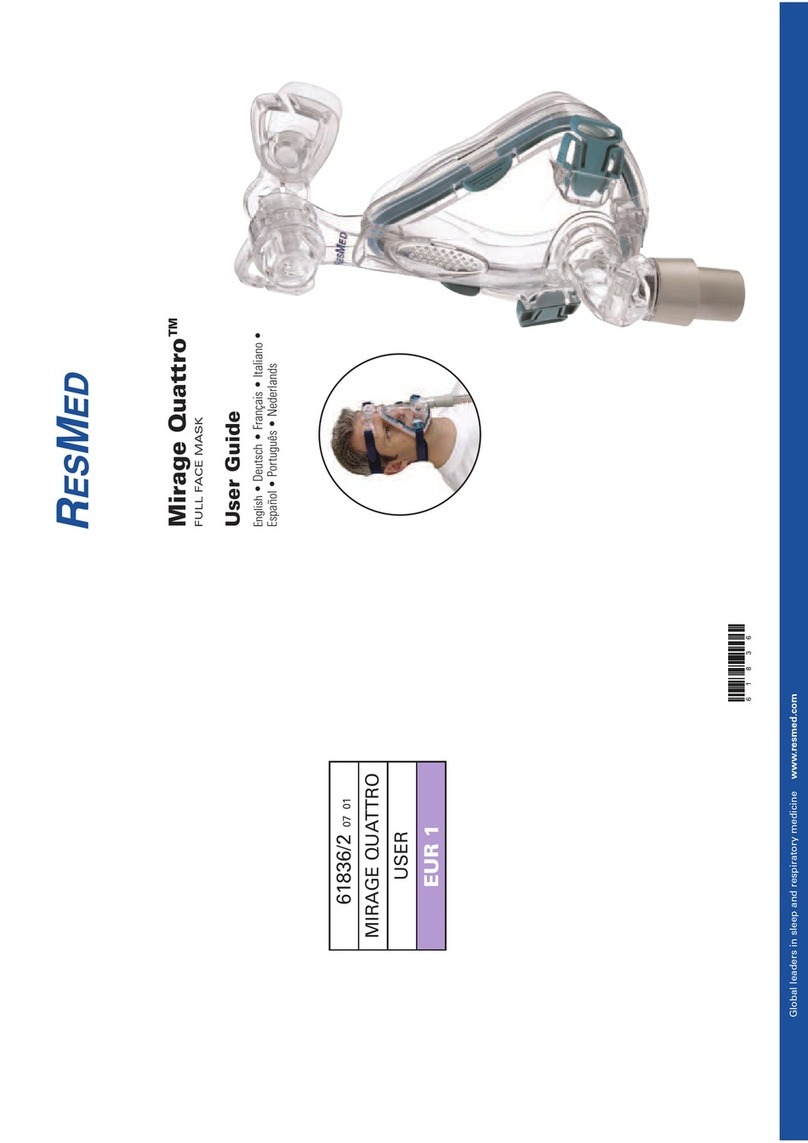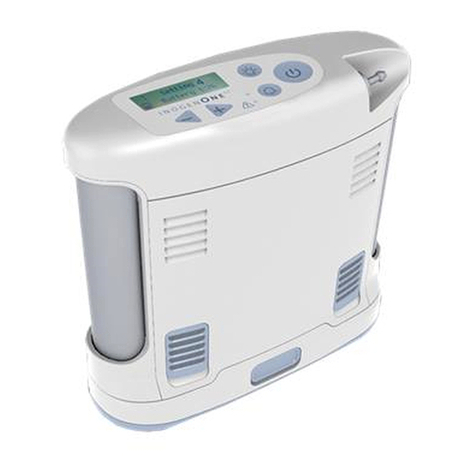MH EDS-D1 User manual

OPERATING MANUAL
for the
EDSModel D1
Electronic oxygen Delivery System
Featuring our Pulse-Demand technology
Patent Pending
R 1.7
AUDIO
D5
D10
D12
D MODES
Unit active
at and
above
selected
pressure
altitudes
MADE IN USA PATENT PENDING
PULSE UNITS
NMODE
Unit active at
allpressure
altitudes
Oxygen Inlet Outlet
!
30
25
20
15
10
5
0
HM
EDSMODELD1
This single person SBA oxygen delivery device is intended for
supplemental breathing while exposed to high altitudes. On
demand and up to 25 BPM, this device delivers a pulse of
supplied oxygen at the start of each inhalation phase. Higher
altitudes are automatically compensated with larger pulses.
AIRCRAFT PILOTS SHOULD REFER TO FAR 23.1447
CONSULT MANUAL FOR PROPER DEVICE USAGE
DEVICE WILL NOT OPERATE PROPERLY UNLESS SPECIFIED
CANNULAS, FACE MASKS & REGULATORS ARE USED
Not intended for SCBA, SCUBA or MEDICAL use
M
o
u
n
t
a
i
n
H
i
g
h
E
&
S
C
o
.
U
S
A
M
H
Aviation
Oxygen Systems
Since 1985
8
0
0
-
4
6
8
-
8
1
8
5
•
M
H
o
x
y
g
e
n
.
c
o
m
•
5
4
1
-
9
2
3
-
4
1
0
0

Basic Safety
The EDS Oxygen system is intended to deliver pure oxygen for the purpose o
f
supplemental breathing and not intended for medical use. Pure oxygen is a highly
oxidizing gas in nature and can vigorously accelerate combustion. It can provide a
catalyst for spontaneous combustion and may cause personal injury or death if not
used properly and with caution. DO NOT use any type of oil or grease on any of the
f
ittings, valves or cylinders. DO NOT use the system while smoking or near an open
f
lame.
NOTICE OF NON LIABILITY
This device/equipment is classified as, and only suitable for use as, a supplementary breathing
apparatus (SBA) or a component/part thereof. It is intended to help supply the needed amount of
oxygen for persons during excursions at high altitudes where supplemental oxygen is advised or
needed. This device/equipment is not suitable for any type of life support operations. This
device/equipment is not suitable for SCBA (Self Contained Breathing Apparatus) or SCUBA
(Self Contained Underwater Breathing Apparatus) or any Medical operations.
It is the responsibility of the user, who will use this device/equipment and who is of sound mind
and body with good judgment, to become familiar with the operation and safety aspects of this
device/equipment, through the supplied manuals and documentation, before it is put to use.
Mountain High E&S Company assumes no responsibly for any accidents, injury or death that may
result from the misuse of this device/equipment. This includes any usage of this device/equipment
outside the scope of common sense and detailed in the operations and safety manuals, inserts and
other related documentation.
* * * * * * * * * * * * * * * * * * * * * * * * * * * * * * * * * * * * * * * * * * * * * * * * * * * * * * * * * * * *
W a r r a n t y
Mountain High Equipment & Supply Co. warranties your EDS-D1 unit/system against defects from materials and
workmanship for long as you own and use it. The conditions are simple; should any part of the system become
defective, ship it to us and we will repair or replace it free of charge (you pay only shipping). This warrantey is only
valid if Mountain High Equipment & Supply Co. has determined that the system or any of its components have not been
damaged from being used improperly, submerged in fluids, dismantled or used in an abusive or unsafe manner.
Mountain High E&S Co. reserves the right to determine if repairs are to be done under warranty or at a nominal charge.
Before this warrantey can be valid Mountain High Equipment & Supply Co. must have your owners guarantee &
registration form properly filled out and in our files.
Mountain High Equipment & Supply Co. is not liable for any property or personal damage caused by misuse of the
system or cylinder. Operating conditions including, but not limited to cylinder and system pressure and ambient
conditions must be considered when refilling cylinder and using the system. Improper use could possibly cause cylinder
failure and lead to possible property damage and personal injury.
* * * * * * * * * * * * * * * * * * * * * * * * * * * * * * * * * * * * * * * * * * * * * * * * * * * * * * * * * * * *

INTRODUCTION
Like our original EDS-A1 Electronic oxygen Delivery System (Analog Computer) the EDS-D1 (Digital
Computer) oxygen system with our Pulse-Demand technology is a single person aviation oxygen delivery system
designed to maximize the administration of oxygen into the human body in the most efficient, comfortable and
convenient way. With new user selectable settings, total apnea alarm and smaller size the new EDS-D1 provides
the same reliable operation that users of the EDS-A1 have come to rely upon and more. The EDS-D1 operates on
known physiological facts that the breathing cycle of a healthy, non-smoking person is such that about one-third of
the time is spent inhaling while two-thirds is spent exhaling and pausing. In addition, between 2/3 to 3/4 of the
volume of air holding oxygen inhaled is not used but is simply exhaled. The human lungs, for their size, are
relatively inefficient compared to other life-support organs. Lungs have to be the most adaptable and are most
easily stressed at altitudes resulting in a reduced efficiency effecting the entire body within seconds. This is partly
because only a fraction of inhaled air, holding oxygen, actually gets to the oxygen absorbing alveolar of the lungs.
The rest is spent in the so-called dead-spaces, i.e. trachea, bronchus, and other areas not directly contributing to
oxygen absorption, where it simply goes unused. Only about 25% to 30% of the oxygen inhaled in a given volume
of air is actually absorbed into the bloodstream. The rest is simply exhaled back out. Studies have shown that
oxygen being delivered only at the very beginning of inhalation
cycles acts better than a constant-flow system. This is because the
EDS-D1 provides oxygen as a bolus at a slightly higher pressure than
ambient that is first to lead into the most functional part of the lungs,
allowing optimum oxygen absorption during times of high altitude
excursions where oxygen is less per volume of air and the absolute
(atmospheric) pressure is lower.
HOW IT WORKS
The EDS-D1 monitors micro-pressures induced from inspiration
efforts. In turn it delivers a precisely metered pulse of oxygen at the
instant inspirations are detected but not during exhalation, pausing or
talking. Ongoing tests are showing that 90% of the oxygen the EDS-
D1 provides to the lungs goes directly into the blood. The EDS-D1
"synchronous inhalation pulse-demand technique" is currently the
most efficient way known by respiratory physiologists to saturate the
blood to well over 90% while using as little as one-tenth the oxygen
over standard constant-flow systems. Field tests with soaring flights
have yielded savings of up to ten times over the conventional delivery
protocol of 1 liter/min. per 10,000 feet. The average user should, however, see an average of 4 to 6 times savings
over constant-flow systems. The EDS-D1 utilizes well known physiological facts providing the smallest, lightest
yet most efficient aviation oxygen system available. Precious oxygen is simply wasted with constant flow systems.
Because of this, many pilots wait until some sort of indication of hypoxia is detected before they begin to use their
limited supply. That is, if the person recognized his indications for hypoxia in the first place. This almost always
results in being well behind the oxygen saturation curve from the start. The EDS-D1 will allow one to use oxygen
at the point where it is needed without the worry of running out before higher altitudes are achieved. The EDS-D1
is intended to be used with regulators and cylinders provided by Mtn. High. Any other cylinder with a near-
compatible fixed-flow or adjustable oxygen regulator may be used. Pilots who intend to fly with the EDS-D1 are
advised to become familiar with the system. The cannula can be used for flight operations up to 18,000 ft. MSL.
which takes advantage of the natural moisturizing exchange mechanism the sinus membranes provide. This will
help prevent so-called "dry-mouth or cotton-mouth" that is associated with diluter demand delivery units or
standard constant-flow delivery protocols. Although the EDS-D1 has shown that it can provide the needed oxygen
with a cannula at pressure altitudes well over 32,000 ft. the user will need to comply with FAA FAR 23.1447 and
use the face mask for flight operations at and above 18,000 ft. MSL. This is because at altitudes where oxygen is
needed it is important that the pilot get the proper amount through either the mouth or nose. A cannula alone can't
provide this assurance. A cannula and face mask is provided with the unit. Face masks, with microphones, may be
adapted or modified to work with he EDS-D1.
Page 1 of 8
EDS-D1
EDS-A1

Color-coded 6 mm.
BLUE
outlet Quick-Connect union
connects to the cannula or
face mask
Color-coded 4 mm.
RED
inlet Quick-Connect
union connects to
the primary reducing
regulator Power On/Off
and Control
Switch
Operational and
precautionary
front face-place
Audio port.
Sound from
flow-fault
and
apnea
conditions only
POSITIVE
FLOW
!
FLOW FAULT
APNEA
LOW BATT
STATIC PORTS
DO NOT COVER
EDS MODEL D1
MH
INLET TO
SUPPLY / CYLINDER OUTLET TO
CANNULA / FACE MASK
Green LED Red LED
Static ports
DO NOT COVER
EDS-D1
Page 2 of 8
High brightness green
LED for indication of
positive flow of
oxygen for each
inspiration effort.
High brightness
red LED for
indication of
oxygen
flow-faults,
apnea and low
battery condition.
External Battery
Cannula
Inside (tip) is neg (-)
Outside (ring) is pos (+)
EDS Unit
EPS
11 - 28 VDC input
The EDS-EPS is a floating
ground unit suitable for
negative or positive ground
systems. Be sure to ground it
to the main system ground.
System Ground
123
9 Volt
Alkaline
Replacing the battery in the EDS unit
Remove the battery door by holding the unit with both hands
and pressing in with your thumbs at the point of the arrow
pushing in while pushing door outwards (fig 1.) This is best
done if the unit is held with the battery door facing up at you
and out. The EDS-D1 unit uses a standard 9 (nine) volt
alkaline battery connector system. This is a very positive-
connecting type connector that requires a bit more force to
connect and disconnect to the battery. This is a superior type
connector for equipment subjected to rough out-door
treatment. Therefore, please take extra care in removing and
replacing the battery making sure not to pull on the wires.
Use only alkaline type batteries with the EDS-D1 unit. If the EDS -D1 unit will be
operating outside in very cold
temperatures, premature
battery depletion may be
likely. An external battery
connector can be wired up to
use an external 9 volt battery
placed somewhere warmer
such as your flight suit. It
can also be used as an
emergency backup,
electronically replacing the
internal battery with the
external battery that is
plugged in the external jack..
Up to (8) eight EDS-D1 units can
be powered from our optional EPS
(External Power Supply) unit if it is
desirable to use the power system
from an aircraft. The EPS is a 10
volt @ 500 ma. low-drop-out
voltage regulator and filter unit that
operates from 11 to 28 volts. It
filters out glitches caused by
hydraulic pumps, strobe lights and
other high-energy devices. It works

Switch as seen in the
full reverse (-), "OFF" setting
OFF
Reverse (-)
push-button Advance (+)
push-button
The EDS-D1 unit is user controlled by a
windowed push button control switch. The switch
has two push buttons, one for advancing through
the modes, the other for reversing through the
modes. A stop is provided inside the selector
switch stopping at the most forward setting
"R/M" and most reversed setting "OFF".
The EDS-D1 has three main modes
of user controlled operation as seen
and described in the text and figures.
They are:
1. Fully-Automatic
2. Semi-Automatic
3. Manual
Page 3 of 8
Control switch settings and modes of operation
Control switch settings (windows) for each of the positions
OFFD10F10F15F20 D5 ND12R/M F25
Fully-Automatic
modes
Semi-Automatic
modes
Manual
mode Unit
off
Unit power on settings
FEATURES
• Easy to use two-button control, small size and light weight.
• Automatically will adjust oxygen flow for different altitudes.
• Allows operation for different oxygen delivery protocols and variable flow regulators.
• Multi-mode push-button control switch allows the setting of various automatic altitude trip points,
Night & Day flight operations and over-ride high flow settings for special or emergency purposes.
• Positive GRN / RED indicators for FLOW / NO-FLOW oxygen delivery status.
• Provides Apnea alarm to inform user of kinked, pinched, disconnected lines or holding breath too long.
• Saves existing oxygen supply by as much as 8 times over standard constant-flow delivery protocols.
• Much less dry-mouth and associated discomfort over standard constant-flow delivery protocols.
• The EDS pulse-demand technology has been recognized by the FAA as having the equivalent level
of safety per FAR. 23.1447 operating with a cannula or face mask.
The EDS-D1 has proven to be very reliable and has been used by many pilots for several years in various types
of aviation. The EDS-D1 unit and has no means inside itself to provide a by pass of oxygen in the event of a
total failure. If this should become desirable, here are a few oxygen bypassing methods you can implement with
optional equipment
The most common emergency
bypassing method is with the A-4
flowmeter/regulator control unit that
couples the outlets of the EDS unit
and the A-4 unit together into one
standard cannula. This allows the
pilot to simply throw an on/off switch
to bypass the EDS unit, then having
the ability to adjust the flowmeter for the altitude.
Because many pilots fly with passengers only part of the time, the A-3 or A4 flowmeter/regulator and an
Oxymizer® cannula can be setup for the bypass station and for the passenger.
Oxymizer is a trade
mark of Chad
Theruputics, inc.

Page 4 of 8
D MODES "Day" or "Delayed" modes
The next three advancing settings are the D5, D10 and D12. These are the Dfor "Day" or "Delayed" modes.
The D5 setting will cause the EDS-D1 unit to delay responding to breathing actions until it senses a pressure
altitude of 5,000 ft. and above. The D10 setting operates respectively. The D12 setting is calibrated to start
operation at a pressure altitude of
about 11,000 ft. ±250 ft. This lower
trip-point setting is intentional so the
unit will comply per FAR part
23.1447 throughout a wide range of
barometric pressures. For example,
because the EDS-D1 unit has no user
adjustments for changes in
barometric pressure, it operates
simply from pressure altitudes such
as your body does. Therefore, if the
unit is being used while the
barometric pressure is low, it will
start operation sooner (at a lower
MSL flight altitude) than it will if the
barometric pressure is high. Therefore, the EDS-D1 is calibrated to trip a bit low to keep the D12 setting from
never violating the current FAR 23.1447 for oxygen use at 12,500 ft. MSL. The D5 is calibrated for a pressure
altitude of 5,000 ft. and D10 is calibrated for a pressure altitude of 10,000 ft.
30
25
20
15
10
5
0
PRESS ALT X 1K
PULSE UNITS
D5
D10
D12
D Modes
Unit delays
activation
until at and
above
selected
pressure
altitudes
D12
Switch as seen in one of the
"Day" or "Delay" settings.
N MODE "Night" or "Now" mode
The first power on setting advanced from off is the Nfor "Night" or "Now" setting. At this setting the EDS-D1
will respond to breathing actions at all altitudes with the standard delivery protocol. The EDS-D1 will deliver
pulses of oxygen at the effective flow rate
of 1.0 liter/min. per 10,000 ft. for pressure
altitudes up to about 34,000 ft.
NOTICE
Using any of the on settings will result in
the correct (or more) amount of oxygen for
any given altitude. None of the on settings
will inadvertently result in inadequate
amounts of oxygen for any given altitude
in which the EDS operates.
N
Switch as seen set to
"Night" or "Now" mode
30
25
20
15
10
5
0
PRESS ALT X 1K
PULSE UNITS
N mode
Unit active at all
pressure altitudes
delivering more
with increasing
altitude.
A
B
C
A
B
C
Align tube
Push
Push tube
firmly
Push
firmly
Push in
collets
Pull tube
out while
pushing
collets
in about
1 cm.
To remove the polyurethane service
line you must push in the connector
collar while you pull on the
polyurethane line. Do not pull the
polyurethane line without pushing in
the collar. It will damage the
connector rendering it useless.

R/M Reserve/Manual
This last, most positive switch setting causes the
EDS-D1 unit to respond to breathing actions with
a fixed 1/2 second long pulse regardless of the
actual cabin pressure altitude. This would equate
to a 100% oxygen flow setting for a conventional
delivery oxygen device. The effective (or
equivalent) flow rate at this setting is about 10
liters per min. This setting is intended to be used
as an emergency setting while still providing a
wide conserving margin. This setting is intended
for situations where the user can indulge in deep
(reserve) inspiration cycles. This setting should provide the primary respiration system (lungs and blood) a
better than 90% utilization of the oxygen supplied during most reserve (deep) inspiration cycles.
The R/M setting should be used while oxygen is supplied by adjustable regulators. Aircraft with built-in oxygen
systems that may have an ACR (Altitude Compensating Regulator) that does not exceed an outlet pressure of 35
psig. By using the EDS-D1 with systems that have an ACR (Altitude Compensating Regulator) the operator
will benefit from a much greater duration in oxygen usage without any modification to the existing system. If
the EDS-D1 unit is used with one of our standard regulators, such as our XCP, XCR, RCV/RCR the R/M
setting is intended for times when you may desire to receive oxygen during the (near) full reserve inspiration
cycle to manage possible acute dyspnea (shortness of breath) and/or anxiety while under stressful and/or
demanding flying conditions. In addition, this setting can be used as a "full-on" mode to pre-charge yourself
with oxygen or for emergency purposes.
Page 5 of 8
30
25
20
15
10
5
0
PRESS ALT X 1K
PULSE UNITS
While in the
"R/M" mode the
delivery curve
is simply at
maximum
regardless of
the pressure
altitude.
R/M
Switch as seen in the
Reserve/Manual setting.
100% delivery or for use
with regulators that are
flow-rate adjustable.
F MODES Floor & Face Mask
These next four settings deserve your attention.
The F-Mode settings are F10, F15, F20 and
F25, called the floor or facemask settings.
These settings cause the EDS-D1 unit to add
additional oxygen equivalent to the indicated
setting, thus raising the floor by that much.
For instance, if you are at a pressure altitude
of 10,000 ft, and you set the unit to the F10
setting you will get an additional (1.0
liter/min.) or 10,000 ft. worth of oxygen added
to the pressure altitude your are currently at.
This results in an effective flow rate of 2.0
liter/min. or a total of 20,000 ft. worth of
oxygen. However, near sea level the settings
will simply add in the effective flow rate of 1.0
liter/min. for the F10, 1.5 liter/min. for the F15, 2.0 liter/min. for the F20 and 2.5 liters/min. for the F25
settings. The F10 or F15 settings are suitable for use with most facemasks.
Changes in pressures altitudes cause the unit to deliver the additional (over and above the floor setting) amount
of oxygen for that pressure altitude. Once again, for example, if you are at a pressure altitude of 5,000 ft. and
you select the F10 setting you will then receive (for each breath up to 25 per min.) the effective flow rate of
5,000 + 10,000 = 15,000 ft. or 1.5 liters/min. The unit will be active at all altitudes (like "N" mode) while in
any of the "F mode" settings. The "F" modes are very useful in situations where you may wish to pre-charge
yourself with oxygen before a long-term high ascent or as needed for losses associated with a facemask. The
"F" modes enable you to ensure proper oxygenation after you have descended from long-term high altitude
flights, even after having descended to flight levels not legally requiring oxygen.
30
25
20
15
10
5
0
PULSE UNITS
PRESS ALT X 1K
N, D5, D10 & D12
F10
F15
F20
F25
F Mode curves
F15
Switch as seen in the Floor
mode. The F15 setting
provides 15,000 ft. amount of
oxygen referenced to sea level
or that respective additional
amount throughout the
pressure altitide curve

Page 6 of 8
Display Information
There are two high brightness LEDs on the EDS model D1. The green LED indicates positive oxygen flow for every breath. The red
LED indicates any flow fault or apnea conditions and blinks for low battery conditions.
FLOW FAULT ALARM
The EDS model D1 will produce an optical (red LED) and audible flow fault alarm from the following reasons:
1. The oxygen supply has been removed.
2. The supply line has become pinched closed, is plugged up or has come off.
3. The battery no longer has the power to energize the valve while under pressure or the valve or line has become plugged
APNEA ALARM
The EDS model D1 will produce an optical (red LED) and audible apnea alarm for the following reasons.
1. The user has quit breathing over a 45 second period.
2. The outlet (cannula) tube has become disconnected.
3. The outlet (cannula) tubing has become pinched closed or is plugged off.
NOTE:
The audio portion of these alarms can be disabled by momentarily (about 1/3 of a second) selecting the "OFF" setting from the "N" setting
and back on to any on settings. The audio alarm will be re-enabled any time the unit turned off for more that two (2) seconds before it is
turned back on.
Low Battery:
The EDS model D-1 unit continuously monitors the condition of the battery during operation. The unit flashes the red LED once every
two seconds to warn that the battery has dropped to about 6 volts. The unit will, however, continue to operate properly for about four (4)
hours @ 25° C after the indicator starts to flash. It will flash the red LED once per second to warn that the battery has dropped to about 5
volts and should then be replaced ASAP. The EDS model D1 will operate for 60 to 80 hours with a fresh alkaline battery under normal
operation. However, because a very small amount of current (≈1 µa.) is drawn by the unit while turned off, the battery life is about 4 to 6
months. Therefore, during long term storage the battery should be removed. Once the battery drops below 5 volts the unit will stop
operating and the red LED will remain on.
External Power:
The EDS model D-1 unit has an external power coaxial type connector (jack). It allows the unit to operate from an external power supply
that provides 7 to 10 volts @ 100 ma. peak current with less than 150 mv. ripple and filters spikes from the primary power bus such as the
EDS-EPS (External Power Supply). The connector is reversed from that of our EDS model A unit. That is, with the EDS model D the
inside pin "tip" is negative (-) and the outside ring is positive (+). A reverse polarity diode 1. A. in the EDS unit helps prevent damage
from accidental short term reverse voltage occurrences.
Misc. notes:
The EDS model D1 has a basic (total) apnea detector. It will only respond with an apnea alarm for total apnea (no event) conditions and
will not consider or respond to any partial apnea conditions. That is, the EDS D1 unit will only produce the apnea alarm if it has not
detected any respiration actions for a period of 45 seconds. Any respiration events within this time will reset the 45 second "time-out"
apnea detector. This type of apnea detection is usually sufficient for aircraft and high altitude (non medical) applications. The apnea
alarm can be used as a "put-your-oxygen-on" alarm once you get to the preset D1 mode altitude. The apnea alarm will not sound if you
already have the cannula or face mask properly on.
The EDS unit is calibrated to deliver just over 2 times more than the equivalent flow-rate of 1 liter/min. per 10,000 ft. This is the standard
FAR protocol as detailed in 23.1447. It can only do this if the regulator feeding the EDS unit can deliver a flow-rate of 25 liters/min. as
measured at the regulator's outlet or a pressure of 1 bar (≈15 psig.) during flow (dynamic) and not during no-flow (static) conditions. This
flow-rate is required to compensate for normal flow losses in the lines, valve and cannula. A flow-rate of 10 liters/min. is needed at the
end of the cannula. EDS delivery calibration augmentations can be done by adjusting the inlet dynamic pressures of the regulator feeding
the unit. Lower pressures result in lower amounts of oxygen. Higher pressures result in higher amounts. Adjustable flow-rate regulators
can be used while the unit is in the R/M setting. Static (no-flow) pressures can be as high as 35 psig. without the user becoming aware of
the increase. Higher inlet pressures will demand more from the battery. Therefore, a low battery that operates the unit sufficiently at 15
psig. may have trouble opening the valve at an inlet pressure at 35 psig., thus causing an occasional flow-fault alarm. Simply replace the
battery to remedy this. If the inlet pressure is too high the valve may not open at all and cause the flow-fault alarm for every inspiration
effort.
Do not store the EDS unit while the inlet is under pressure. Remove all sources of oxygen pressure and secure the unit to ensure it will not
become damaged. If the lines are disconnected they must be covered so that debris, dust or dirt can't get in. If the supply line is left
hooked to the system, make sure that it is first purged with clean dry air or oxygen before the EDS unit is connected.

Page 7 of 8
Service, Maintenance & Care
of the EDS-D1 unit
Life expectancy
With the exception of the electromechanical valve and
mechanically operated control switch, there are no parts
or sensors inside the EDS-D1 that will age, cure or
become out of tolerance in time and use. Therefore,
EDS-D1 unit does not require any regular or periodical
maintenance or calibration.
The electromechanical valve has a service life of well
over 150 million pulsing cycles. The respiration sensor
has a service life of well over 500 million pulsing cycles.
At this time the valve and sensor may need replacing.
If the unit is used in an application where dirt and dust
are present, the electromechanical valve may become
clogged with debris that may cause the flow to decrease
or not allow it to shut off completely. If this happens you
can usually remedy the problem by back-flushing the
valve. This is done by supplying a small amount of air
or oxygen pressure into the large (6mm) outlet line while
the electromechanical valve is placed in open state.
To clear a clogged valve follow these steps:
1Remove the 6mm blue union from the outlet side of
the EDS-D1 unit and replace it with a 4mm to 6mm
reducing union.
2. Connect the 4mm line from the regulator (source)
into the reducing union. If a reducing union is not
available, connection can be done by pressing
(sliding) the 4mm tubing into the inside diameter of
the 6mm outlet tube on the EDS-D1 unit.
2With the EDS-D1 unit initially off, turn on the
cylinder valve slowly to allow gas from the regulator
to back-charge the outlet side of the EDS-D1 unit.
Next turn the EDS-D1 unit on. During the time the
EDS-D1 unit initializes the valve will open for about
1/2 second. Do this several times over to purge any
particles that may be clogging the inlet side of the
valve.
If the above steps do not correct the described problem,
the EDS-D1 unit is not functioning correctly or if you
would like it checked out for calibration you can send it
to Mtn. High E&S Co. for diagnosis and repair.
Stowage
While not being used the EDS-D1 unit should be
stored in a secure manner to ensure that dirt and
debris do not enter and become lodged in the inlet and
outlet tubes.
The battery should be removed from the EDS-D1 unit
if it is to be stored for an extended period of time.
CAUTION
If the back-flush purging will not be done with an
XCR regulator do not apply pressures over 35 psig
into the outlet of the EDS-D1 for this may cause
the breathing sensor to rupture.
A
B
C
A
B
C
Align tube
Push
Push tube
firmly
Push
firmly
Push in
collets
Pull tube
out while
pushing
collets
in about
1 cm.
Inserting and removing the polyurethane tubing
4mm.
polyurethane
tube end Reducing Union
4mm. to 6 mm.
3cm. long 6mm. wide
polyurethane
interconnector tube
User supplied (soft type)
tubing. 1/8" I.D.
polypropylene,
polyethylene.
6mm to 4mm
reducing union
Outlet
Inlet
EDS unit
XCR
regulator
Air or
oxygen
source
Each time the
EDS-D1 unit is
turned on it will
open the valve for
about 1/2 second.
Do this as many
times desired to
free debris that
may be clogging
the valve.
4 mm. to 6 mm. reducing union kit

Max. respiration rate allowed (triggered hold-off time): Fixed @ 30 BPM in R/M mode
Higher altitudes allow slightly higher maximum respiration rates (BPM):
0-10K ft. = 20 BPM, 12-20K ft. = 22 BPM, 21 - 25 = 25 BPM and 26+ = 30 BPM
Apnea time-out envelope: Fixed @ 45 sec.
The apnea alarm does not respond if in any of the "D" modes and while below that pressure altitude threshold
Operating inlet pressures: 1 bar (15 psig.) DYNAMIC (flowing) through cannula and 1.5 meters (5 ft.) of 4 mm. inlet tubing
2 bar (30 psig.) STATIC (non-flowing) 2.2 bar (35 psig) MAX.
Operating Voltage & Current @ 25° C. @ 25% RH. (measured in "N" mode setting @ 15 RESP/ typical.):
Low-v. cut-out: 5.00 VDC+0 mv. -250 mv. (red LED on steady)
Min.: 5.50 VDC @ 2.25 ma. idle (100 ma. peak, 3.25 ma. mean) (Low batt. red LED winking 1/sec.)
Low: 6.50 VDC @ 2.25 ma. idle (100 ma. peak, 3.25 ma. mean) (Low batt. red LED winking 2/sec.)
Nom.: 7.85 VDC @ 2.25 ma. idle (100 ma. peak, 3.25 ma. mean)
Max.: 11.0 VDC @ 4.30 ma. idle (100 ma. peak, 3.25 ma. mean) (EPS provides 10 VDC)
Reverse voltage protection:
Diode shunt (1 amp peak max., no internal fuse or over voltage protection provided)
External Power is provided via a 3.5 mm. coaxial power-jack system. Inside (tip) is negative (-) Outside (ring) is positive (+)
Battery Life:
Operating: 40 to 60 Hr's @ 25° C. @ 25% R.H.
Measured from mean, assuming fresh alkaline battery operating under normal operating conditions.
Storage: Approx. 4-6 months while in the off setting. (battery drain is about 1 µa. in the off setting)
Make sure that the battery is removed from the unit during long-term storage.
Battery type:
Standard 9 volt alkaline DURACELL type MN1604 or equivalent.
Operating temperature and humidity (assumes nominal operating voltage):
Min.: 0% RH @ -55° C to +80° C.
Nom.: 25% RH @ +25° C.
Max.: 100% RH @ +50° C. near condensing
Allowable vibration during operation:
Random vibration 5 to 500 Hz, 15 minutes per axis @ 2.5 g. (rms.) sin wave;
Physical characteristics (EDS-D1 unit only):
Width: 2.60" (6.60 cm.)
Height A: 4.10" (10.41 cm.) enclosure only
Height B: 6.25" (15.87 cm.) enclosure and inlet/outlet tubes with connectors
Depth: 1.50" (3.81 cm.)
Weight: 8.0 Oz. (0.227 kg.) with battery
Physical characteristics Regulator only (XCR type standard issue):
Width A: 1.25" (3.17 cm.)
Width B: 2.10" (5.33 cm.)
Height: 2.25" (5.71 cm.)
Weight: 4.0 Oz. (0.113 kg.)
Page 8 of 8
Height
Width
Depth
Front view Top view
≈100 mm.
Height
Width
A
B
Outlet
CGA-540 or DIN 477
cylinder inlet
Testing and characterization was done under normal
operating conditions i.e. EDS at 25°C and responding
to a respiration rate of about 16 breaths per minute
without any flow fault or apnea detection's.
General Specifications
This is a list of specification parameters for the EDS model D-1. These specifications are operational and performance standards or
limits against which the unit was tested or calculated. Specifications are subject to change without notice.

Top view of
EDS-STR regulator.
The EDS regulator
stabilizer unit is designed
to allow up to six EDS
units to be operated from
a built-in oxygen system
where the pressure is 20
to 125 psig. thus
replacing the standard
issue XCR regulator.
The EDS regulator
has a self-sealing
4mm. outlet for
interconnecting the
EDS unit(s) via the 4
mm. service line.
If the XCR
regulator will
not or can not
be used the
EDS-STR
regulator
should then
be used.
4 mm. inlet line 6 mm. outlet
FLOW
Outlet is
fitted with a
Self-sealing
quick-connect
for 4 mm.
tubing
Inlet
barb for
user
supplied
1/8" ID
tubing
Side view
The EDS regulator is for use with existing
(built-in) oxygen systems/sources.
XCR Regulator
or
EDS-STR Regulator
TEST-SET
PN MHTG3060
with 0-4 bar (0-60 psig)
pressure gauge
Regulator
under test
Air or
oxygen
source
EDS unit
Do not
obstruct
cannula
during
inlet
pressure
test
EDS
cannula
Test-sets are available directly from
Mountain High E&S Co.
Acceptance testing the dynamic
(flowing) and static (not flowing) outlet
pressure performance of a regulator for
use with an EDS unit
NOTICE
IMPORTANT EDS INLET
PRESSURE NOTICE
If The EDS-D1 unit(s) will not be used with the XCR, XCP,micro-lite
system or EDS-STR regulator the alternate regulator must be able to
deliver a dynamic (flowing) pressure of 1 bar (15 psig. +0.0 - 2.5 psig.)
and a static, no flow, pressure between 1 and 2 bars (15 and 30 psig.)
This is the inlet pressure measured directly at the inlet of an EDS unit
while the valve is open and an EDS cannula is connected to the outlet or
left open. If the above listed pressure specifications are not met the it
may compromise the operation and ability of the EDS-D1 unit(s) to
deliver the correct amount of oxygen at altitudes. Lower that specified
inlet dynamic pressures will result in lower than needed volume of
oxygen pulses. Higher pressures will result in higher than needed
volume of oxygen pulses. Uncalibrated, dysfunctional or undesirable
operation of and/or damage to the EDS unit(s) may result from
operating with dynamic inlet pressures above 2 bars (30 psig). and static
inlet pressures above 3 bars (43 psig.). Inlet pressures above those listed
herein cause the valve to automatically relive inlet pressures through the
outlet, not allowing the EDS unit to detect any inspiration efforts.

For size and weight critical applications our µ-lite (micro-lite) valve and
regulator system with our new light-weight and small 'S' series cylinders offer
compactness and capability never offered before.
Complete single and multi-place carry-on EDS system packages are
available along with padded fabric carry/strap-down harnesses for
most of our kevlar-fiber and aluminum cylinders
Aviation Oxygen
Management Systems
625 SE Salmon Ave, Redmond, OR. 97756
Tel: 541-923-4100 Fax: 541-923-4141
MH
www.mhoxygen.com
Table of contents
Other MH Oxygen Equipment manuals
